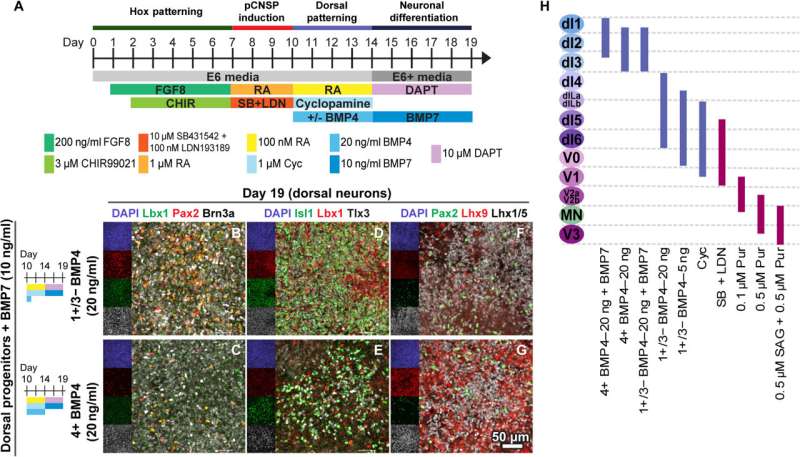Home » Health News »
Improved understanding of early spinal cord development paves the way for new treatments

Researchers at the University of Wisconsin–Madison are developing the means to turn stem cells into a wide range of specific types of spinal cord neurons and cells in the hindbrain—the critical nexus between the spinal cord and the brain—paving the way for improved prevention and treatment of spinal cord disease.
In a new study published in Science Advances, scientists from UW–Madison’s Stem Cell & Regenerative Medicine Center describe a new protocol for differentiating human pluripotent stem cells into nearly the full spectrum of neuronal cell types that arise during early hindbrain and spinal cord development—important, because neuronal cells have so many different, specialized jobs within the body. The study also uses new bioinformatic analyses to capture previously unknown information about their development in humans.
“The ability to study human hindbrain development so early is of high significance because many developmental disorders manifest themselves through disruptions in the developmental program very early,” says Sushmita Roy, co-author of the study and a UW–Madison professor of of Biostatistics and Medical Informatics and faculty at the Wisconsin Institute for Discovery. “Having a model system to study this process will help us understand possible regulatory or genetic causes of different developmental diseases.”
Combining Roy’s experience with machine learning and gene regulatory networks, and biomedical engineering professor Randolph Ashton’s expertise in neurodevelopment and stem cell bioengineering, the labs developed a unique resource mapping the gene expression changes that mark differences between neuronal cell subtypes along the hindbrain and spinal cord.
“This is something that we, as scientists, really haven’t had good access to before, but stem cells are allowing us to start exploring this,” says Ashton, associate director of the SCRMC, also faculty at WID, and CEO and co-founder of Neurosetta, LLC. “With this paper we can start to fill in those gaps of understanding of how human development occurs in the hindbrain and spinal cord and provide a really nice tool that essentially can lead to a very standardized and scalable protocol to manufacturing regenerative cell transplants.”
With access to subtypes of neuronal cells and information about how they develop and interact in different regions of the spinal cord, Ashton expects researchers will soon be able to manufacture specific cell types for any damaged region of the spine for transplantation and effective post-injury regeneration.
“This is important because the cell types in different areas of the brain and spinal cord are very region specific,” Ashton says. “In order to get the best therapeutic results, you need to actually make cells from that region of injury. So now we can say, if you need neuronal cells for your C3 through C5 vertebrae, we know how to generate those, and we have developed a scalable protocol for doing that.”
While there is still much more work to be done before their findings make waves in the clinic, Ashton says that the new study will help researchers screen for therapeutics that could correct abnormal developments in utero that lead to various neurodevelopmental and neurological disorders early on in human development.
Source: Read Full Article


